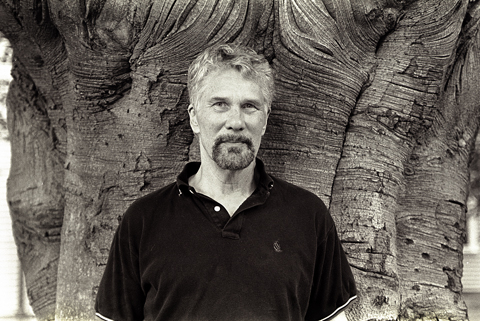
BAREFOOT AND LOVING IT Wagoner combines homespun groundedness with an ability to let fanciful ideas take flight. |
Summer Stages Dance kicked off its 2010 performance series at Concord Academy a week ago Thursday with a film of a woman setting the table. Methodically, as if she had all the time in the world, she puts down plates, pours water into graceful glasses. Muted light comes in from a window over the table. A bluegrass tune plays in the background. You think how pleasant it would be to sit down to dinner here, how the meal would be wholesome and the conversation easy.
This was one of many engaging rustic scenes we saw from the 1976 WGBH-TV special George’s House, as its choreographer, Dan Wagoner, hosted a retrospective evening of his career as a dancer, company director, and teacher. Born in West Virginia, Wagoner lived a country life as the youngest of 10 children. His parents were resourceful. They knew how to make things and take advantage of what nature provided for free. Wagoner got a degree in pharmacy, but he wanted to dance. This was unheard of in his neck of the woods, but his father said he ought to go ahead and try.
For 10 years or so, Wagoner danced with Martha Graham, then with Paul Taylor. He started to choreograph in 1967; soon he left Taylor to form his own dance company, which toured through the years of the Dance Boom. Since the early 1990s, he’s been teaching; he’s currently on the faculty at Florida State University. He’s been a revered teacher at Summer Stages Dance since 2001.
What strikes you about Wagoner is how he combines a homespun groundedness with an ability to let fanciful ideas take flight. He’s a serious person who can talk about the beauty of handmade objects and half-abandoned houses, who can recite Emily Dickinson and Frank O’Hara. Asked by historian Connie Kreemer in 1982 what he was trying to do with his choreography, he said, “I’m trying to follow my instincts with commitment and delight. I’m trying to demonstrate my life.”
His dances can be zany and tender. In George’s House, he and Sally Hess sit together on a pine bench and, like intimate friends, curl around each other, balance and relax in every kind of posture you can imagine, without leaving the bench. It’s a very sensual dance but not really erotic — more like something they’re imagining together, a shared levitation.
Wagoner did a number of imaginary dances with his partner and collaborator, poet George Montgomery, who was also very direct and serious and whimsical. In 1969, they did Brambles in a tiny New York performance space called the Cubiculo. While Wagoner danced, Montgomery showed the audience an imaginary house, walking the rooms and marking the size and placement of invisible fenceposts. Later he offered paintings the audience could have simply by visualizing them.
Several of Wagoner’s company dancers came to Concord to pay tribute to their leader and perform bits from his work. Gwyneth Jones and Janice Garrett did a galumphing Mutt-and-Jeff duet from his 1983 ’Round This World Baby Mine. Sally Hess and Christopher Banner shared a two-minute remembered embrace. Elizabeth Ross, a recent Florida State graduate, showed Wagoner’s latest work, which is set to John Adams’s A Short Ride in a Fast Machine. In a wild and driven few minutes, Ross evoked Dan Wagoner’s own dancing — the jitters and pauses, the sense of overflowing movement.